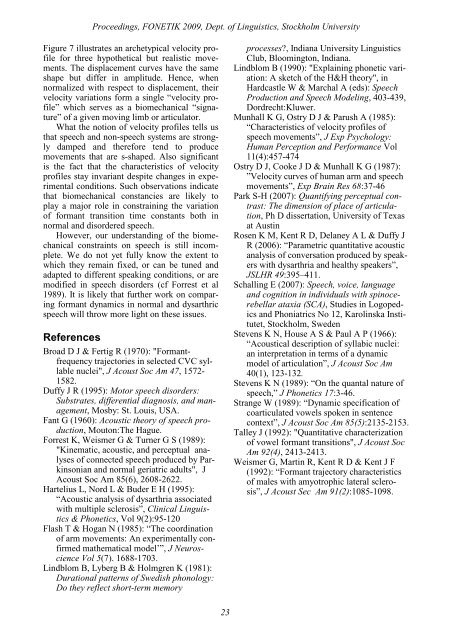Proceedings Fonetik 2009 - Institutionen för lingvistik
Proceedings Fonetik 2009 - Institutionen för lingvistik
Proceedings Fonetik 2009 - Institutionen för lingvistik
You also want an ePaper? Increase the reach of your titles
YUMPU automatically turns print PDFs into web optimized ePapers that Google loves.
<strong>Proceedings</strong>, FONETIK <strong>2009</strong>, Dept. of Linguistics, Stockholm UniversityFigure 7 illustrates an archetypical velocity profilefor three hypothetical but realistic movements.The displacement curves have the sameshape but differ in amplitude. Hence, whennormalized with respect to displacement, theirvelocity variations form a single “velocity profile”which serves as a biomechanical “signature”of a given moving limb or articulator.What the notion of velocity profiles tells usthat speech and non-speech systems are stronglydamped and therefore tend to producemovements that are s-shaped. Also significantis the fact that the characteristics of velocityprofiles stay invariant despite changes in experimentalconditions. Such observations indicatethat biomechanical constancies are likely toplay a major role in constraining the variationof formant transition time constants both innormal and disordered speech.However, our understanding of the biomechanicalconstraints on speech is still incomplete.We do not yet fully know the extent towhich they remain fixed, or can be tuned andadapted to different speaking conditions, or aremodified in speech disorders (cf Forrest et al1989). It is likely that further work on comparingformant dynamics in normal and dysarthricspeech will throw more light on these issues.ReferencesBroad D J & Fertig R (1970): "Formantfrequencytrajectories in selected CVC syllablenuclei", J Acoust Soc Am 47, 1572-1582.Duffy J R (1995): Motor speech disorders:Substrates, differential diagnosis, and management,Mosby: St. Louis, USA.Fant G (1960): Acoustic theory of speech production,Mouton:The Hague.Forrest K, Weismer G & Turner G S (1989):"Kinematic, acoustic, and perceptual analysesof connected speech produced by Parkinsonianand normal geriatric adults", JAcoust Soc Am 85(6), 2608-2622.Hartelius L, Nord L & Buder E H (1995):“Acoustic analysis of dysarthria associatedwith multiple sclerosis”, Clinical Linguistics& Phonetics, Vol 9(2):95-120Flash T & Hogan N (1985): “The coordinationof arm movements: An experimentally confirmedmathematical model’”, J NeuroscienceVol 5(7). 1688-1703.Lindblom B, Lyberg B & Holmgren K (1981):Durational patterns of Swedish phonology:Do they reflect short-term memoryprocesses?, Indiana University LinguisticsClub, Bloomington, Indiana.Lindblom B (1990): "Explaining phonetic variation:A sketch of the H&H theory", inHardcastle W & Marchal A (eds): SpeechProduction and Speech Modeling, 403-439,Dordrecht:Kluwer.Munhall K G, Ostry D J & Parush A (1985):“Characteristics of velocity profiles ofspeech movements”, J Exp Psychology:Human Perception and Performance Vol11(4):457-474Ostry D J, Cooke J D & Munhall K G (1987):”Velocity curves of human arm and speechmovements”, Exp Brain Res 68:37-46Park S-H (2007): Quantifying perceptual contrast:The dimension of place of articulation,Ph D dissertation, University of Texasat AustinRosen K M, Kent R D, Delaney A L & Duffy JR (2006): “Parametric quantitative acousticanalysis of conversation produced by speakerswith dysarthria and healthy speakers”,JSLHR 49:395–411.Schalling E (2007): Speech, voice, languageand cognition in individuals with spinocerebellarataxia (SCA), Studies in Logopedicsand Phoniatrics No 12, Karolinska Institutet,Stockholm, SwedenStevens K N, House A S & Paul A P (1966):“Acoustical description of syllabic nuclei:an interpretation in terms of a dynamicmodel of articulation”, J Acoust Soc Am40(1), 123-132.Stevens K N (1989): “On the quantal nature ofspeech,” J Phonetics 17:3-46.Strange W (1989): “Dynamic specification ofcoarticulated vowels spoken in sentencecontext”, J Acoust Soc Am 85(5):2135-2153.Talley J (1992): "Quantitative characterizationof vowel formant transitions", J Acoust SocAm 92(4), 2413-2413.Weismer G, Martin R, Kent R D & Kent J F(1992): “Formant trajectory characteristicsof males with amyotrophic lateral sclerosis”,J Acoust Sec Am 91(2):1085-1098.23
















